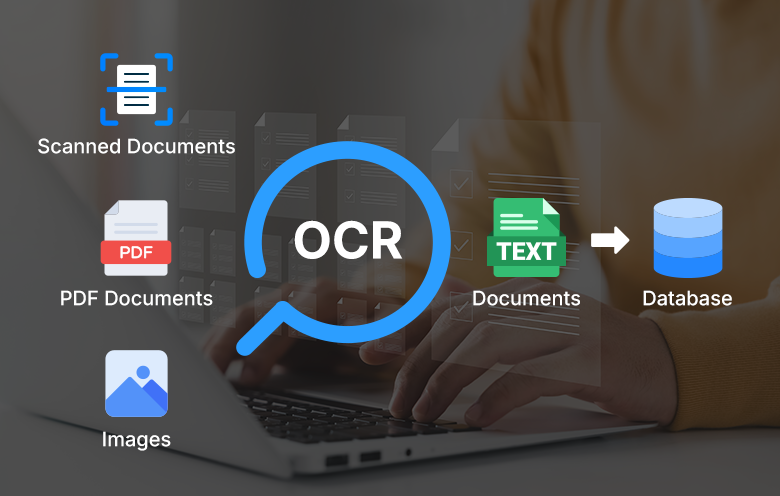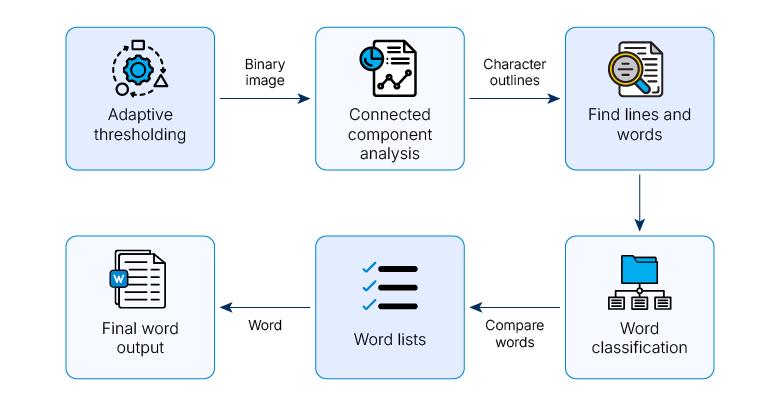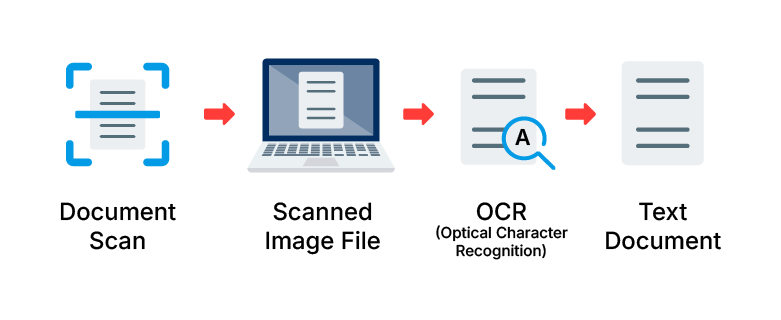

Data locked in hard copies of scanned images, and invoices increase manual work and slow down business operations. Optical character recognition (OCR) eliminates this laborious work by converting images of text whether printed, handwritten, or typed into machine-readable text.
Businesses using OCR technology can easily reduce errors, enhance compliance and minimize processing times. Optical character recognition services can turn this benefit into real world outcome whether integrating into finance automation, customer verification or document processing.
In this blog post, we will explore how OCR works, its benefits, and application across various industries.
Understanding optical character recognition
Optical character recognition is a process that extracts and repurposes data from scanned documents, images, and PDFs. OCR identifies letters in an image, creates words, and then builds sentences, making the text easily accessible.
Organizations often use this technology to turn printed legal documents into text that users can search, format, or edit using a word processor. OCR in computer vision is an AI-powered technology closely connected with machine learning and pattern recognition.
For instance, in number plate recognition system, computer vision technology is used to detect the number plate, machine learning identifies the character and pattern recognition interprets fonts from various angles. All these technologies work in synergy to produce an output called optical character recognition.
Automate monitoring process and generate insights from images and videos
Step by step guide on how OCR works
Let’s understand the process through which OCR works.
1. Image acquisition
All the documents are captured through scanning and photographing. The OCR turns the captured image into a black-and-white version. The digital image is transformed into binary data for further processing. The OCR identifies the black portion as characters that need recognition and the white portion as background.

2. Pre-processing
In this step, the OCR software cleans the image and removes the error, and the digital image is processed for text recognition. The image is cleaned by correcting misalignment and removing graphic lines and boxes in the printed image. It also removes the speckles and noise that might interfere with text recognition.
3. Text recognition
This stage typically involves targeting words, characters, or blocks of text. The dark portion of the image is processed to find alphabetic letters or symbols. Characters are then identified using pattern and feature recognition.
- OCR software compares the scanned text with pre-trained templates of characters in different fonts and characters. Each unique shape, scale, and font combination is called a glyph.
- OCR software identifies unfamiliar fonts by identifying intersections, curves, and lines. For instance, “A” is recognized by its two diagonal lines and a horizontal bar. Once the character is recognized, it is converted into ASCII code for computer processing.
Pattern recognition
Feature recognition

4. Layout recognition
In this step, the OCR program analyzes the layout of the document image and then segment the pages into elements such as image, table, or text. The liens are further divided into text. After the characters are identified, OCR compares it with a predefined image pattern. The programs then come with an output of recognized text.
5. Post-processing
The final step involves collecting the recognized text and storing it in a usable digital format such as a DOC or DOCX, TXT, or PDF. Some systems store both the input image and the OCR-generated image to make comparison and correction easier.
Suggested: Top 8 computer vision trends for 2025 and beyond
Benefits of OCR for image digitization
Let’s understand the benefits of adopting OCR as a service for your business.
- Searchable text: It converts image data into a searchable digital database that is easier to retrieve and use when needed.
- Reduces manual time: It eliminates the need for data entry. It saves time and reduces manual work by quickly transforming text from paper into digital format.
- Cost savings: The cost of storing, preserving, and handling physical data is more costly than digitizing them. Data stored in the digitalized form can be protected from natural disasters or human incidents.
- Integration with AI: It is often used with AI for applications such as detecting logos in social media or reading the number plates of cars.
Application of OCR
As we look around, we see the application of OCR in our daily lives, whether personal or professional. Let’s dive in and understand the application of OCR in the real world.
1. Banking and finance
Banking industries must maintain documents such as contracts, invoices, cheques, and loan statements. Digitalizing all the documents, streamlines the process making it easy to get access to the document when required. OCR in document processing enables banking and finance sectors to integrate paper documents with digital workflow improving efficiency.
2. Health and pharmacy
Optical character recognition service has become crucial for people with physical impairment. This technology scans the physical document or digital text and reads it aloud through a device.
Additionally, it is used to transcribe handwritten prescriptions making it easier for pharmacists to verify and fill prescriptions accurately.
3. Law enforcement
Optical character recognition software is used in many countries to recognize number plates ensuring national security and road violence. This technology has revolutionized parking systems, toll roads, and law enforcement enhancing security and border control.
4. Legal
OCR document processing helps digitize historical legal records, legal case files, and contracts. This process makes it easier to search and retrieve data and extract key details from the contracts
Advancements in optical character recognition
Latest advancements in OCR technology have centred around improving accuracy and streamlining complex process. Computer vision solutions play a vital role in defining the OCR innovation landscape. Through the integration of text and visual information, such models have improved in terms of accuracy, especially in cases with complex layouts or degraded images.
- Multilingual OCR: Latest OCR technology can support many languages, so documents from all over the world can be processed.
- Deep learning: Deep learning algorithms, especially Convolutional Neural Networks (CNNs) and Recurrent Neural Networks (RNNs), have greatly enhanced OCR accuracy, especially in removing background noise or poor-quality images.
- Handwriting recognition: Today, with newer OCR software, it is also possible to identify handwritten text and digitize it for further usage.
Streamline your business workflow with OCR in computer vision
Optical character recognition (OCR) technology has improved the process of text digitization enhancing business processes and improving productivity. By transforming printed or handwritten text into structured digital data, OCR enables automation, improves data accessibility, and powers intelligent workflows. Modern OCR in computer vision accurately processes and analyses text-based reports making the process quick and easy.
Softweb Solutions offers optical character recognition services that enable organizations to quickly and accurately digitize wide range of documents and generate valuable insights from the data unlocked. We help businesses to convert their data into machine-editable text. It is the most effective solution to capture data from printed or written text from a scanned document or image file. Our OCR solutions ensure high-quality data conversion that is fast, accurate and efficient.
Contact us for a custom-built OCR application to streamline your business operations.
Need Help ?
We are here for you